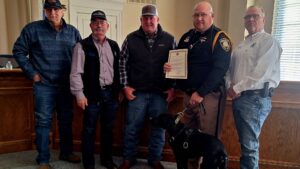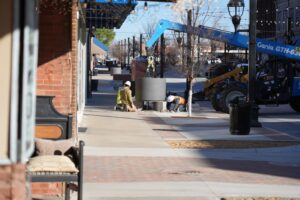Undersheriff Joe Thompson, who is also the Department’s resident tech guru, gave the Sapulpa Herald a guided tour and a demonstration of the capabilities of this impressive vehicle.
According to Undersheriff Thompson, this vehicle has a dual purpose. The first is to serve as an Incident Command Center during a disaster and, secondly, to function as a mobile PSAP (Public Safety Access Point), should a community’s 911 dispatch become inoperable for any reason.
This technological marvel incorporates the latest technology in every aspect of this command center on wheels. To put it another way, this vehicle is nerd nirvana.
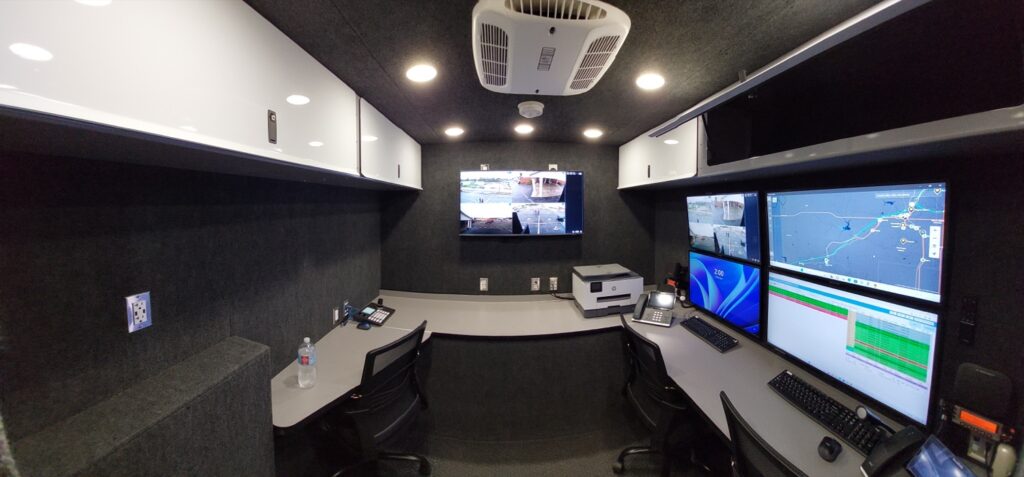
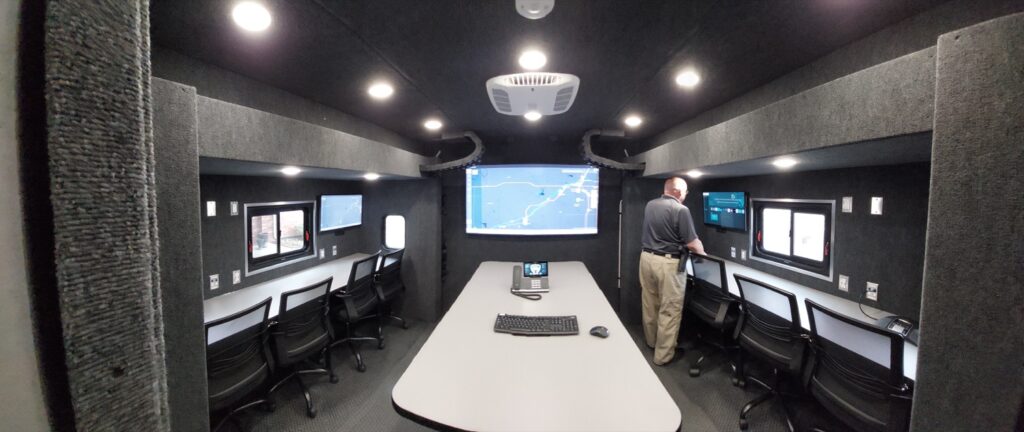
Thompson began the demonstration by showing how most of the features of the mobile command center can be accessed remotely. “If we are going to deploy something, I can do it from here or certain approved phone devices.”
Thompson activated the sliding extension that gives the command center extra room for a conference area. He explained the reason for controlling this feature from the outside of the vehicle: “You can actually open the sliders if you are wanting to open up the conference room, but if you are in a tight space, you want to do it outside, not inside the vehicle.
When you are dealing with equipment like this, you want it to last for years it is important for me to be out here to watch it.”
Since the vehicle was inside a building, he could not raise the mast which contains lights, camera, and an antenna.
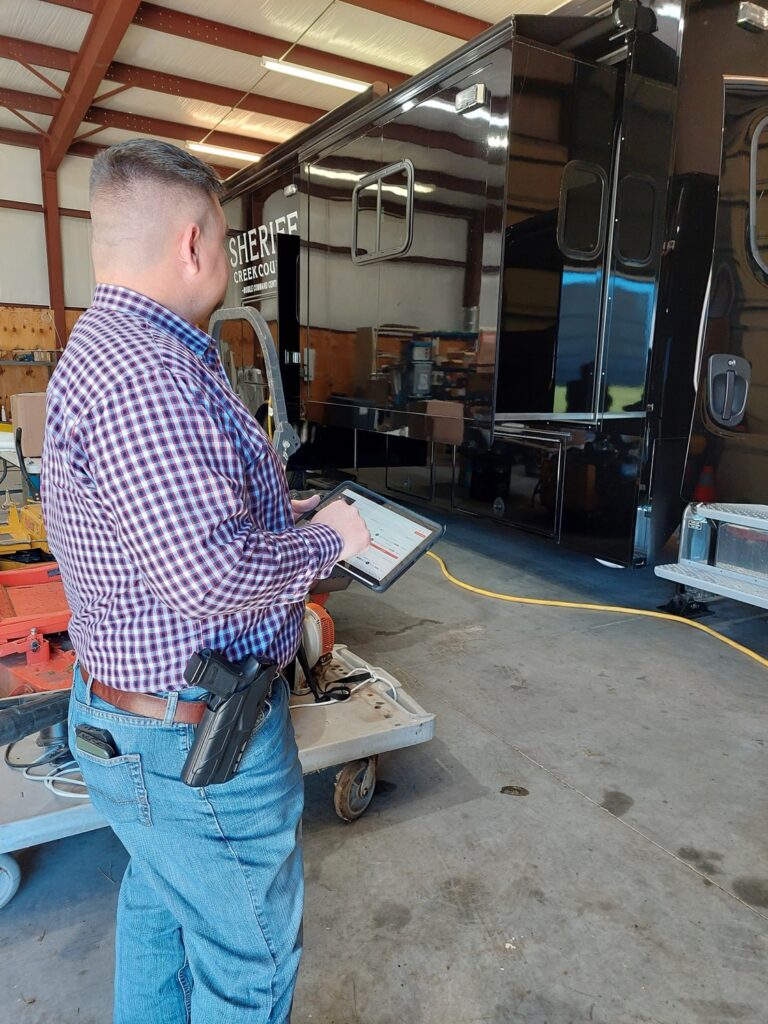
Thompson touted the safety factors built into the vehicle: “One of my favorite portions about this vehicle to protect the asset is all of the safety features to prevent users from forgetting something, leaving something down, or keeping something deployed. If the vehicle needs to be moved, the vehicle is going to tell them if the hatch is open, or if things aren’t stowed correctly.”
When asked about the possibility of someone going for an unauthorized joyride, Thompson replied: “You gotta know how to do it, you can have the key, and you are still not going to go anywhere.”
The tablet Thompson was holding displayed the status of such things as the temperature inside the vehicle, and the voltage and frequency of the AC power, as well as whether the power is supplied externally or through the built-in Uninterruptible Power Supply or the onboard generator.
Thompson, while pointing out a small display in the roof of the cab, explained its purpose: “see the options on that screen up there? Those red options are all those sensors telling the truck, ‘hey, these are all the things you have to check off before you can move this thing.’ ”
Strong in the driver’s seat, one notices the mirror is a split-screen camera display. One-fourth of the screen shows a view as if you were looking down at the top of the vehicle while in the air, the other part of the display is the backup camera.
The Undersheriff then opened the access door to the Cummins diesel generator. “We are hoping that we can get somewhere around 24 hours operating under a full load (with everything in the vehicle turned on).”
The vehicle primarily communicates with the outside world via cellular signals and incorporates a sophisticated multi-SIM (Subscriber Identity Module) gateway (cellular router) that allows the vehicle to access up to six different carriers. “It uses multiple carriers to gather as much data as it can…If we are in a good place, we are going to be using all of them, but we may be in some place that only has one or two carriers providing service,” said Thompson. It also is equipped for radio and satellite communication but is currently set up to only receive satellite signals. If that isn’t enough, the vehicle has the capability to connect to a hardwired Local Area Network.
The vehicle’s communication system utilizes Virtual Private Networks, thus allowing the mobile command center to function as a land-based facility. “It is just like us being in our office, we don’t have to have remote-type dialing. If someone wants to transfer me a call from dispatch, it is simply a transfer button and three digits, or their “quick” keys work, there are a lot of really cool features to it.”
The camera on the mast is a Point-Tilt-Zoom camera. “We can tell it what to do, we can tell it to patrol, to look for movement, whatever we want it to do. The camera also has an infrared spotlight. If you do want to see something a long way off, and you want to zoom this camera in, at the same time, it is zooming its optical lenses, it is zooming an invisible light. You can light something up several hundred yards away.”
When drones are deployed, personnel in the vehicle can see what the drone operators are seeing and interact with them.
The video displays in the vehicle are connected to an HDMI switcher. “I can display eight different options on all the different screens inside the vehicle,” Thompson stated.
Thnopoin pointed to the control center in the hallway of the vehicle, which resembles the cockpit of an airplane, from which all the features can be activated. On the other side of the hallway was the server rack which also contained the HDMI control box, the “brains’ and final stage of the police radio, and of course an uninterruptible power supply.
While Thompson was displaying the Computer Aided Dispatch screen on a monitor, a call came through from dispatch on the police radio stating there was a garage fire, within seconds a fire icon appeared on the screen pinpointing the announced location of the fire. It should be noted that the CAD system allows dispatch or administrators to see where assets and manpower are located at any given time.
The vehicle also employs Apple TV streaming devices to facilitate the casting from Apple mobile devices to any monitor screen.
The command center is essentially divided into two parts, one that can be used for dispatch, and the other section can be used as an Incident Command Center. There are two heat and air units, and a door separating the two sections to allow privacy in both sectors.
The command center has the standard amenities such as a bathroom, mini-fridge, microwave, and coffee maker.
The interior utilizes every square inch. The walls are lined with an outdoor-carpet material that allows Velcro items to be attached to the walls, even the metal cabinet doors are dual-purposed, they also serve as dry-erase boards. The flooring is a specialized rubber-coated-non-slip material And last but not least this space-age vehicle has a built weather station to monitor the ambient temperature, wind speed, barometric pressure, and relative humidity.
The 33,000-pound vehicle is on a Freightliner chassis, and the command center was custom-built by a company called Nomad. The walls are all aluminum, as well as the support structures.
Creek County Emergency Management will have access to the vehicle and, according to Thompson, helped provide input for the specifications.
The mobile command center cost $600,000, however, it should be pointed out that no local taxpayer money was involved. It was purchased with ARPA funds allocated to the County.




